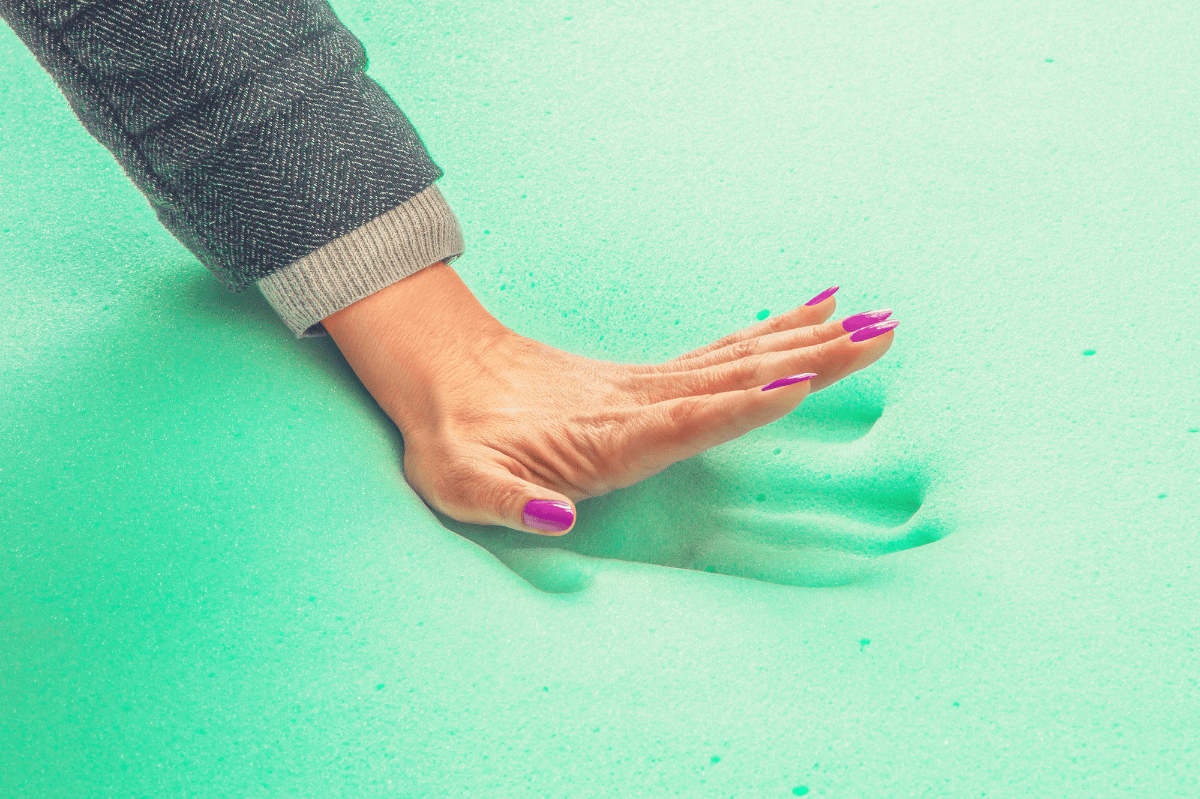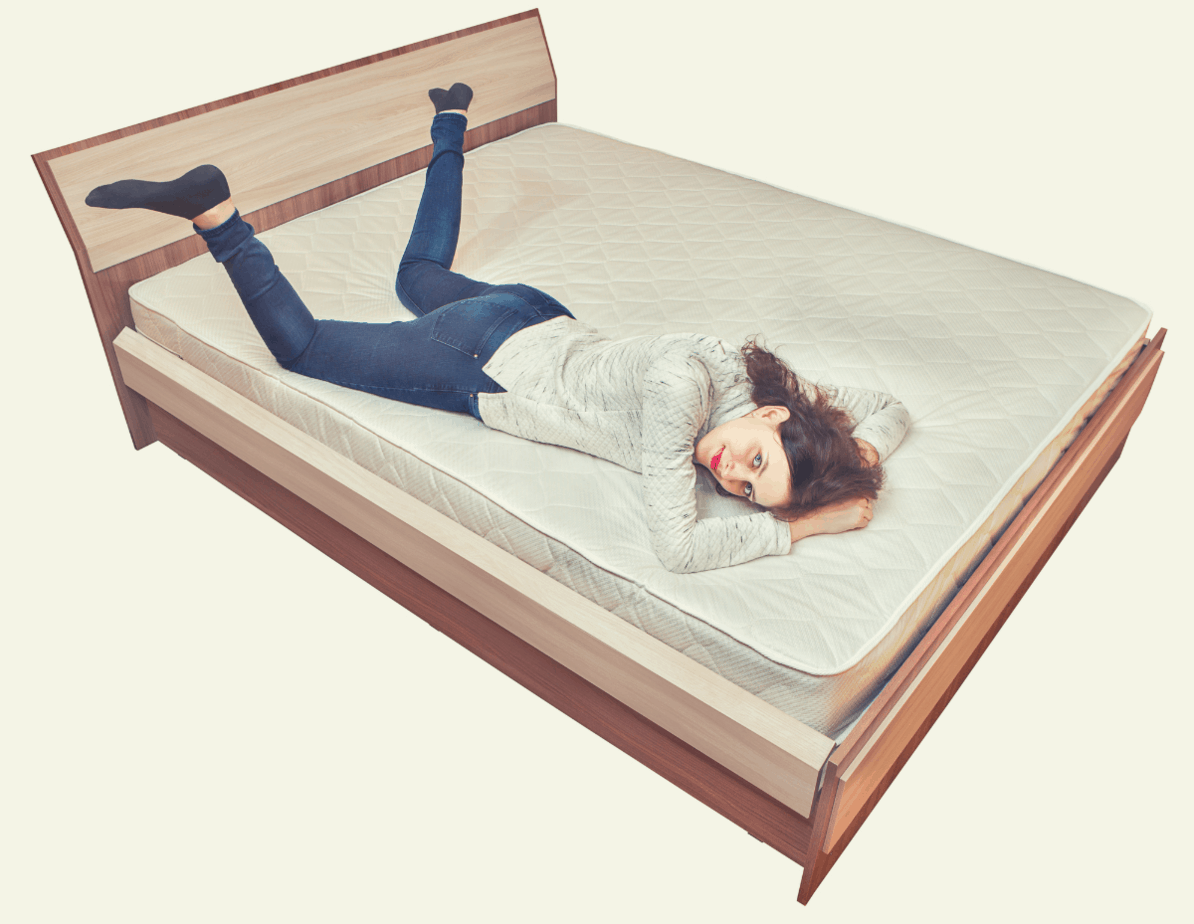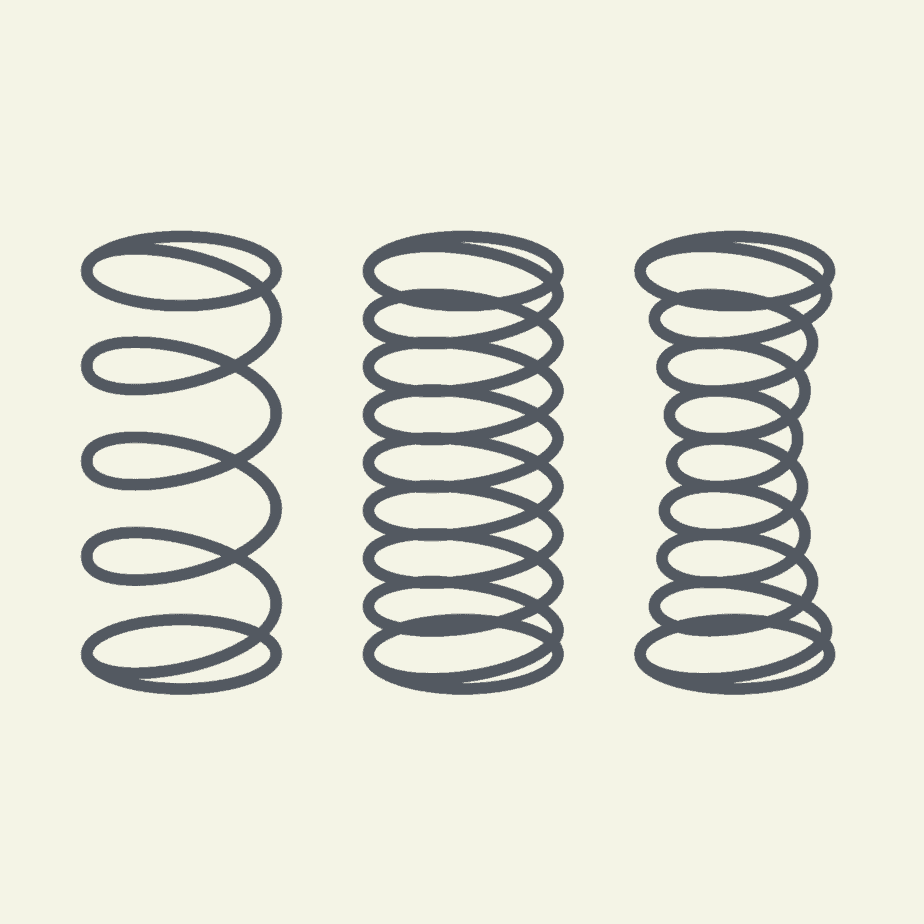Buying a new mattress can be a nervous period especially for first-timers. The availability of multiple options on the market means the battle to choose the right one can leave you with many sleepless nights. Two of the most popular types available right now are foam and coil mattresses.
But which one is the best between mattress coils and foam? Well, the best mattress is the one that gives your body the maximum comfort. Each of the two types offers positives over the other so the personal circumstances of the sleeper usually determine the winner.
Shall we take a closer look at the difference between foam and coiled spring mattresses to make the decision process as easy as possible?
Mattress Coils vs Memory Foam
Both mattress coils and foam mattresses have a lot of positives to offer and a few negatives. This means the best one for a particular consumer will depend on personal circumstances and preferences.
Shall we dive into a few comparisons between the 2 popular types of mattresses so you can make a quick and definite decision?
Foam Mattresses vs Innerspring Models: Bounce
The built-in spring components of mattress coils make them the kings of buoyancy and bounce. If you’re used to lying down on something bouncy, you should look at innerspring models.
Latex offers some degree of bounce which is a step ahead of memory foam and other polyurethane foams. But this bounce is relatively limited compared to what is on offer when you opt for spring mattresses.
Pocket spring models, in particular, offer more pronounced bounce due to the individually encased nature of the integrated coils. This is why coiled springs are so popular among stomach sleepers and consumers that prefer an immediate bounce.
Unfortunately, the bouncing effect can be a big issue if you share a bed with a restless sleeper. The pronounced buoyancy can cause sleep disturbance from your partner’s in-bed movements. In some cases, the situation can get so bad that you may be forced to move to the sofa or another bedroom to catch some sleep.
If your partner tosses and turns frequently, memory foam mattresses could be your best bet. Their nature means a delayed response to the sleeper’s movements. This can help you sleep through the night with little to no disturbance.
Additionally, memory foam mattresses offer localized bounce which further insulates one partner from the other’s movements.
Latex foam offers some bounce but it can be relatively subtle meaning you can still get a good night’s rest even if your partner moves a lot throughout the night.
Foam Mattresses vs Innersprings: Temperature Regulation
Do you frequently suffer hot flashes or night sweats in bed? Things could go further downhill if you opt for foam mattresses.
The denser nature of memory foam, in particular, can make life miserable for hot sleepers. This is because their integrated airways may be minimal which can make them more susceptible to heat-trapping especially during hotter times of the year.
The earliest generations of memory foam had terrible heat issues but there have been vast improvements in the last couple of years as the technology advances. Manufacturers are integrating gel beads and other components that promote improved airflow and minimize the trapping of heat.
Even with that, memory foam may not be the best option for those living in hot regions or naturally hot sleepers. If you’re a big fan of memory foam, you should look out for models that utilize extra cooling technologies.
Mattress coils, on the other hand, promote optimal airflow naturally. The presence of steel coils and minimal foam layers means the sleeper’s body heat easily dissipates throughout the mattress. Thus, you can expect to sleep cool even when room temperatures are higher than normal.
The downside is that during winter and other chilly periods of the year, your bed can get so cold that you may have to snuggle under a couple of heavy blankets for warmth.
I have been sleeping on the Zinus Support Plus Innerspring Mattress from Amazon for the past 6 months and I’m loving every minute in bed. With thousands of positive reviews from verified buyers, it is the real deal. Check it out today if you prefer coiled spring mattresses.
Foam Mattresses vs Mattress Coils: Price Tags

Your budget is probably the most important consideration when shopping for a new mattress. Memory foam models used to come with extremely high price tags when they were first introduced into the market.
But over the last decade, prices have declined as the technology became more commercialized. At the moment, the price tags for foam mattresses and coiled spring models tend to hover around the same range.
The integration of premium features and technologies can increase price tags significantly. But whatever your budget, there’s a mattress coil model or foam model out there for you. Just be aware that latex models are typically more expensive than memory foam and innerspring mattresses.
Foam Mattresses vs Mattress Coils: Comfort and Pressure Relief
Foam mattresses, especially memory foam, rule the mattress world in terms of comfort and pressure relief. The primary structure of memory foam enables molding to conform to the individual contours of the sleeper’s body.
This means major pressure points such as the spine, shoulders, and neck receive just the right amount of support, unlike other sleeping surfaces. The body, therefore, sinks into memory foam versus the feeling of lying on it as found in coiled mattresses.
besides, memory foam compresses to your body’s curves meaning personalized comfort and support regardless of your weight, height, and other physical features.
Unfortunately, this can become problematic during hot periods as the foam components can cause significant heat retention and discomfort. During winter and chilly periods, the foam surface can also harden to the point where there’s no response to your body’s movements.
Fortunately, the latest memory foam models are engineered with significant airflow improvements. This is achieved through the integration of cooling gel beds and open-cell structures.
The level of comfort available in mattress coils usually depends on the type of coil integrated as well as other components such as the quality and quantity of foam layers. Bonnell Coil and Continuous Coil models usually offer zero to minimal comfort and should be avoided.
However, the majority of Offset Coil and Pocket Coil models deliver considerable pressure relief for sleepers. The only problem is that they’re usually at the higher end of the market price-wise.
Foam Mattresses vs Innersprings: Durability
If you’ve been looking into memory foam and other foam mattresses then you’ve probably come across several models with 10-year warranties. Some brands even offer lifetime warranties for purchases because foam models can be extremely durable.
During shopping, keep in mind that the most durable memory foam models are at least 5 lb per cubic feet. Anything less and you’re risking the probability of ending up with a mattress that sags within the first couple of years.
Additionally, memory foam is easy to handle. Just flip your mattress 180 and 360-degrees every couple of months to prevent excessive pressure that can cause wear and tear at one side.
The latest spring mattresses are more durable than previous ones. But, the presence of springs can make them susceptible to sagging and other quality issues.
Over time, the uniformity of the springs also reduces, which can lead to several problems including poking. Just as in foam models, it is vital to rotate your innerspring mattresses a few times throughout the year. This can prevent indentations from your preferred sleeping spots.
Foam mattresses are the best choice if you’re looking for something that can easily take you through the next 8-10 years with minimal effort.
Foam Mattresses vs Innersprings: Scent
One of the main issues associated with memory foam is the strong new mattress smell. This scent can be so intimidating that you may struggle to sleep when your brand new mattress arrives. People suffering from respiratory infections such as Asthma may report aggravated symptoms from new foam mattresses.
This is why many brands recommend leaving your mattress to air out for 48 hours to reduce the smell.
Thus, memory foam can be a terrible option when you need a brand new mattress due to an emergency.
Innerspring models give off no strong smells so sleeping on them immediately after delivery is OK. This can make them the perfect choice for emergencies such as receiving guests out of the blue.
Foam Mattresses vs Innersprings: Sleeping Positions
Your preferred sleeping position can determine which side of the mattress coil vs Foam debate you support. Side sleepers thrive on memory foam as they enable the shoulders and hips to sink in. This releases the pressure on those delicate areas leading to more comfort in the morning.
Tummy sleepers usually prefer foam latex models as they allow their bodies to achieve balance in terms of bounce and pressure relief.
Innerspring mattresses provide the right support for back sleepers by offering spinal alignment. The superior support from the integrated springs can also serve the needs of back sleepers well throughout the night.
Have you read the article we wrote on the best cooling mattresses for hot sleepers? Click here to find out the best models available on the market.
Extended Guide for Foam Mattresses
These mattresses contain one type of foam or the other with additional components that trap air to provide bounce and support for the sleeper’s body. The number of foam types on the market is increasing by the day with various brands coming up with new inventions.
However, the 3 types currently trending on the market are:
- Memory Foam
- Foam Latex
- Polyurethane Foams
Memory Foam

Memory foam consists of traditional polyurethane foams blended with chemicals to enhance the density and responsiveness. Originally known as “Temper foam” or “Slow Spring Back Foam”, their open-cell structure promotes airflow.
This foam was first invented in 1966 by NASA to enhance the comfort and safety of aircraft cushions. The magical effects of the foam made it popular in the wheelchair industry as manufacturers sought more comfort for the injured and those with mobility issues.
Memory foam’s propensity to eliminate or at least minimize pressure sores for those who remain in one position for several hours in a day is one of the main reasons behind its commercial adoption. The first commercial mattress to sport this high-end foam was released in 1991.
The foam’s reputation and popularity have been on the up ever since.
Memory Foam’s ability to conform to the individual curves of each sleeper to promote pressure point relief is one of its strongest properties. If you’re suffering from stiffness and aches in areas such as the back, knees, and shoulders, memory foam mattresses can provide soothing relief.
Additionally, mattresses sporting this foam appear denser and heavier compared to other foam mattresses.
My girlfriend’s Zinus 12-inch Green Tea Memory Foam Mattress is one of the reasons why I love sleeping over at her place. After a long stressful day, it provides amazing cradling and pressure point relief for my joints and muscles. This allows me to wake up fully refreshed and she swears by it too.
Foam Latex
Foam latex springs from a combination of tree sap from the rubber plant and various foaming agents. This blend results in an air-filled matrix structure that offers a supportive and bouncy feel which stays consistent across every inch of the mattress.
Foam latex is renowned for its endurance compared to other polyurethane foams such as memory foam. The result is a natural firmness that makes it stand tall above its peers.
If you’re environmentally conscious, foam latex may be just what you need thanks to the overall cleanliness of the manufacturing process.
The main component is a natural ingredient derived from rubber tree sap. Besides, the majority of manufacturers rely on chemicals that are milder to the environment compared to the petrochemical-based ingredients used for memory foam.
Foam latex was first discovered in 1929 but commercialization in the United States and Europe began in the 1940s.
Foam latex can be manufactured via 2 main processes.e. Talalay and Dunlop. Talalay is rated by industry experts as the most innovative manufacturing method. It produces mattresses that are more uniformed in terms of shape and density.
No wonder Talalay latex models usually come with higher price tags compared to their Dunlop rivals.
Dunlop latex models, on the other hand, usually offer higher densities at the bottom compared to the top due to the nuances of the manufacturing process.
The good news is that the majority of modern manufacturers rely on the Talalay process. But you can always speak to your favorite foam latex mattress brands to find out the specific manufacturing process of prospective models before confirming your order.
We found the best latex mattress available online – the LUCID 10-inch Latex Mattress on Amazon. It features natural latex material, offers world-class breathability, and comes with a 10-year warranty.
Polyurethane Foams
These are high-resilience foams usually integrated as the comfort layer for innerspring mattresses. They may also form the base for memory foams before the addition of various chemicals to improve density.
Polyurethane foams are considerably lightweight compared to memory foam. They provide more bounce which makes them easy to handle.
From sofa cushions to coiled spring mattress layers, hybrids, and even standalone mattresses, poly foams are popular in a wide range of applications.
Poly foams come in 3 main grades, with the highest grades offering more in terms of comfort and durability.
Extended Guide for Mattress Coils

Mattress coils also known as spring mattresses come in the form of internal steel coils suspended on other materials. Even with the growing popularity of foam mattresses, spring coils continue to thrive thanks to the quality of support they offer for consumers.
While Millenials are moving away from spring mattresses due to the availability of “sexier” options, older generations have stuck by them. Mattress brands also continue to release coil models due to the rumored high-profit margins compared to foam products.
But what do mattress coils offer for your sleep? The truth is spring mattresses are probably the most supportive due to the ability to push back with a greater amount of pressure on the sleeper’s body.
This ensures a maximum springy feel and bounce levels that dwarf the competition. While most foam mattresses are relatively new, innerspring models have been around since the middle 20th Century.
They continue to remain popular despite the growing competition from foam mattresses. This has gone against industry expert predictions which largely towed along the lines of coiled springs going extinct after foam mattresses became prominent in the 1950s.
Spring coils are engineered with thousands of interconnecting coils of different densities at the center. Apart from making the mattress more bouncy, these coils form the heart of the mattress’ structure.
Like other types, coiled models offer varying degrees of comfort, bounce, and durability. This is determined by the style of construction as well as the number and type of interconnecting coils.
The type of insulating foam featured may also play a role in the level of comfort a particular spring coil mattress provides.
Types of Mattress Coils

Mattress coils come in different shapes, sizes, and characteristics. Since each mattress model features one type of coil or the other, it is critical to know the various types available. This can help you make the right choice during shopping.
Here are the main types of coils integrated into mattresses right now:
- Continuous coils aka Mira-coils – a single piece of wire forms the basis of all the coils. They’re featured in innerspring models at the lowest end of the market.
- Bonnell Coils – these are the original mattress coils to hit the market. The springs are wired together to form Bonnell units in hour-glass shapes with knots and round-top features.
- Offset Coils – they’re also hour-glass shaped coils with flattened top and bottom areas of twists.
- Pocket Springs or Marshall Coils – thin coils independently encased in pockets of fabrics. They’re typically more durable because the weight on one spring is independent of the other thereby improving the sleeper’s buoyancy feel.
Conclusion
After going through our detailed comparisons, we’re sure you have an idea of what to choose when it comes to foam vs innerspring models.
Whichever type you opt for, choose a mattress from a reputable brand renowned for releasing top-quality products. Additionally, pay attention to the individual features of each model as well as reviews from other customers.
Don’t forget to read through the warranty covering your mattress as well as any other terms and conditions such as sleep trials and money-back guarantees.
